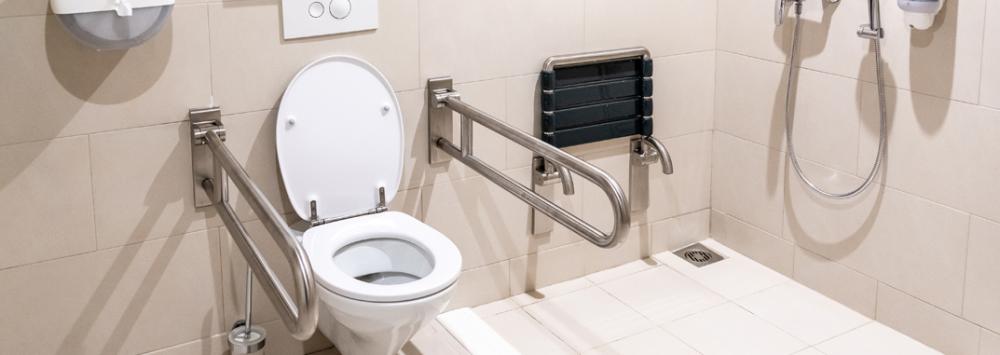
5 Products that help with Bathroom Safety for Elderly People
Sally Madeley-Carr, OT02 Dec 2020
For people living with balance or coordination problems, the bathroom is an area of the house in which it is important to remain safe.
Tiling and other wet surfaces can be hazardous, especially when wet, so for people who might be unsteady on their feet, it's worth taking precautions.
Here we'll run down five of the top bathroom safety products for elderly people or others with mobility issues.
1. Grab rails
One logical safety feature is to fit rails around the bathroom. Positioning them in strategically sensible spots makes sense, so think carefully before deciding where they should go.
Most people opt for rails near the toilet, the bath, in the shower cubicle and sometimes next to the sink.
In all these areas, it's possible that the person concerned might need a bit of extra support.
Using the washbasin for example, it's usually necessary to stand up while you wash your face, brush your teeth or use the mirror. If you have a condition which affects your balance, this may become challenging.
The addition of a rail next to the sink provides a leaning point which you can hold on to as you use your other hand for washing etc. Essential Aids has a wide range of bathroom grab rails which do exactly this job.
There are lots of models to choose from, some of which have a textured grip, making them easier to hold securely even with wet hands.
These ones are particularly useful next to the bathtub or in the shower cubicle.
A support rail for getting in and out of the bath is something many elderly people find useful.
If your mobility is restricted, getting your leg over the side of the bath, lowering yourself and raising yourself in and out is often an awkward process. Having a support rail to help, may make a big difference.
Essential Aids supplies rails that fit to the wall next to the bath, but also have a selection which attach to the side of the bath, protruding upwards.
These types have an upside down U-shape design, providing a curved rail right in the middle of the bath, just where it is most needed as you get in and out. They fix by means of clamps, which securely grip the bath side, creating a stable leaning point.
The U-shaped rail may also be useful when you are out of the bath as you get dressed.
Most grab rails have either a white or chrome finish so tend to be easy to blend-in with your bathroom's appearance.
If you have poor eyesight, it might be worth considering high visibility red rails.
The Essential Aids range has a variety of lengths, so you can find one for the space you have available.
While straight grab rails remain the most common, angled versions are also available. These allow you to hold them with your wrist in a neutral position, a shape which some people find more comfortable.
Remember that it's important to have bathroom rails fitted by a qualified tradesman. They will use non-corrosive fixings and be aware of the type of wall the rail is being fitted to.
2. Non-slip mats
Slipping on wet floors is the number one cause of accidents in the bathroom, so taking every step possible to guard against it makes perfect sense.
As mentioned above, fitting support rails provides a useful safety feature, but using non-slip matting on the floor can also make a big difference.
Essential Aids does a range of non-slip mats which are perfect for this setting, creating high friction surfaces to tread on. Some of the mats we supply are conventional bath and shower matts, with either suckers or other tacky 'feet' which adhere to the floor of the bath or shower.
A high-friction mat is a classic bath aid for elderly people or others who might be prone to slipping.
Available in numerous dimensions, you're bound to find one which fits your requirements.
If you want matting to cover larger areas in say a wetroom, you may want to consider our popular Stayput matting.
Stayput creates a very high friction surface in wet environments, ideal for those who are at greater risk of falls, like the disabled or elderly.
It works even on floors which traditional suction mats can not be used, because the existing flooring is uneven or textured in some way.
Made with a special PVC foam, it uses 'Silver' technology which makes it both anti-bacterial and anti-microbial.
This type of matting does not contain either rubber or latex and is easy to cut to the size required. It can even be machine washed.
3. Perching stools
If you are unfamiliar with perching stools, think of them as high stools which have a seat which slightly slopes from back to front.
The user then 'semi-sits' on the front edge of the seat while keeping their feet on the ground.
This therefore removes much of the weight burden from the feet and legs, making it easier to maintain an upright posture.
This posture is suitable in the kitchen at worktops or the sink, but also in the bathroom.
Perching stools are excellent bathroom safety products for people who find it a challenge to stand up for any length of time. This may be because of fatigue, strength, balance or coordination issues.
Using a perching stool at the bathroom sink to brush one's teeth, wash or use the mirror can make a big difference to someone's daily routine.
Essential Aids supplies a range of these stools, most of which are designed without corrosive parts, making them ideal for use in wet environments.
Perching stools can be easily adjusted for height via the pin-clip mechanisms found in each of the legs.
They are typically white or chrome, so they blend into standard bathrooms.
If there is enough space, you can also use certain perching stools in the shower cubicle for people who have difficulty standing for the duration of a shower.
It's important to check the amount of floor space and the footprint dimensions of the stool before purchasing it. Make sure too that the shower tray's base is flat enough to create a stable surface.
4. Bath seats and shower boards
Bath seats are an effective way of raising the floor of the bath, reducing the distance of travel from standing up to sitting down.
Many people with mobility issues find this process difficult, so a bath seat may well be helpful.
While using a bath seat means it's hard to submerge yourself in water, it does give you the opportunity to get in and out of the bath with less strain.
Most seats fit to the base of the by means of high friction feet or suction cups. As with shower stools for cubicles, it's important to measure the space available and compare it to the footprint dimensions of the seat concerned before buying.
Seats like this provide an excellent bath aid for elderly people and others with reduced mobility.
5. Gripping aids
Arthritis in the hands and fingers is a common problem for many elderly people across the UK. For those in this situation, items which reduce the pressure required to hold narrow objects like toothbrushes, or to grip and create extra leverage on taps, may be useful.
Tap turners fit to existing taps and assist the twisting process by effectively increasing the amount of leverage force the user can apply. They do this by means of extended prongs.
They are great for classically designed taps which need a fair amount of force to turn on and off.
It's worth remembering that 'ceramic disc' taps do not usually require such force, making them a better option if you are making changes in the bathroom and have arthritis in your hands.
Another aid which may be of interest to those with hand arthritis, are those which build-up the handles of toothbrushes.
Gripping narrow objects may cause pain in the hands and fingers, so increasing the diameter of the brush may help comfort.
It can be done by either wrapping the handle in tape, but also by using purpose made foam tubes into which the toothbrush is inserted.
These products were originally designed for use with cutlery, but they are excellent for toothbrushes and other narrow bathroom tools.
Other items
The bathroom safety products mentioned are not the only ones available, but they are some of the most commonly used. Essential Aids supplies a wide range of other items which improve not just safety, but also comfort in the bathroom.
Bath cushion for example, is a product which many people find enhances their comfort as they lay in the bath. If you have fragile or sensitive parts of your body, using a bath cushion to pad these areas can make a big difference.
Stretching up to reach the body's extremities is another task which those with mobility issues may find hard. Using long-handles brushes, combs, scrubbers and other reaching aids may help.

Sally Madeley-Carr, OT
Sally qualified as an Occupational Therapist in 1996 and is a well-respected professional in the field of rehabilitation equipment and living aids. She has worked in private practice and within the NHS, developing a broad experience with adults and children. Click here for Sally's registration with the Health and Care Professions Council. The HCPC regulates health, psychological and social work professionals in the UK.